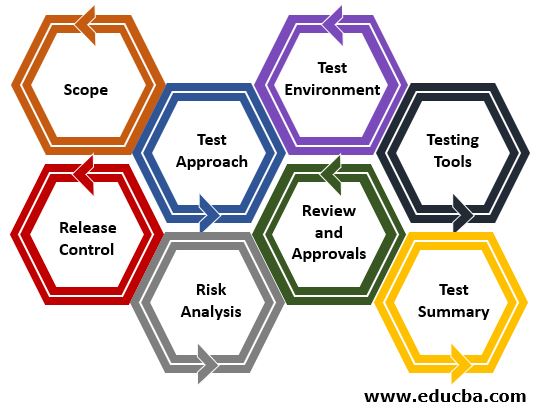Updated May 30, 2023

Introduction to Test Strategy
Test strategy is the document that describes the testing approach of the software product. The test strategy is created to inform project managers, developers, and testers about key issues of the testing process. The test strategy describes how the risks must be mitigated at the test level, what criteria are needed to apply, and the type of testing that needs to be performed. Writing a test strategy is a skill that one develops with experience. We should circulate the testing strategy with the whole project team to ensure a consistent approach and clarify responsibilities for everyone involved.
How to Create Test Strategy?
Every organization has unique rules and priorities for software development. Hence the process of creating a test strategy document varies. Always ensure the document is compatible and add values to the development process before following any template.
Generally, a test strategy document contains below sections:

1. Scope
In this section, the scope of testing activities will be mentioned. What to test, Why to test, who will review this document, who will approve this document, and the timelines.
2. Test Approach
This section usually contains the following:
- Test Levels: In this subsection, we define the level of testing, such as unit testing, integration testing, system testing, and user acceptance testing.
- Test Types: In this subsection, we define the type of testing, such as load testing, security testing, performance testing, etc.
- Roles and Responsibilities: In this subsection, we describe the roles and responsibilities of the project manager, lead, and individual testers.
- This section also defines the testing process.
3. Test Environment
This section defines the requirement for the test environment. In a software company, there could be more than one test environment. E.g., Staging environment, QA Environment (Quality Assurance), Dev Environment, and Production environment. The staging environment is sometimes called UAT (User Acceptance Testing). This section will describe the need for an echo system required for a developed project.
4. Testing Tools
This section will describe the automation testing tools and test management tools. There are hundreds of tools out there in the market for testing. It depends on the type and size of a project for a testing tool to be chosen. Management tools like JIRA, Asana, etc. Automation tools like Selenium, Appium, etc.
5. Release Control
This section will describe the release plan with the appropriate version history. This will help to maintain the test execution with modifications for that release.
6. Risk Analysis
This section will list all the risks involved in the testing process and how to mitigate them.
7. Review and Approvals
All of the activities mentioned above require a review and a sign-off by the business team, project management team, development team, etc.
8. Test Summary
This section describes the test summary reports to be produced with frequency. These reports could be generated daily, weekly or monthly basis.
As mentioned earlier, the document varies from organization to organization. The organization’s policies may dictate adding or removing a few sections from the document.
Importance of a Test Strategy
Now why do we need an approach before testing the product? Product creation requires quality design, ingredients, and a method in any industry. Here Quality is a big word. If your product does not reach some quality standards, say bye-bye to the product.
So it’s all about making a quality product. In the software industry, it is essential for a product to undergo testing before its release to the outside world. Before testing the product, it requires some set of planning and approach. A team of quality engineers sits together and decides which type of testing requires a product to consider its Quality.
They decide on a strategy describing what to test, how, and when. And all those need to be documented somewhere. Here comes the test strategy document. It is the first and crucial document for the testing process. Writing a good test strategy document improves the complete testing process. It clearly defines what the test team will do for the project. Hence it should be circulated with the entire team.
Conclusion
The test strategy document is static. It means that it doesn’t change very often. The test plan is derived from this document. As this document will drive the entire team and is static, The document needs to be prepared by someone with good experience.
Recommended Articles
This is a guide to Test Strategy. Here we discuss the basic concept, how to create a test strategy and importance. You may also have a look at the following articles to learn more –

